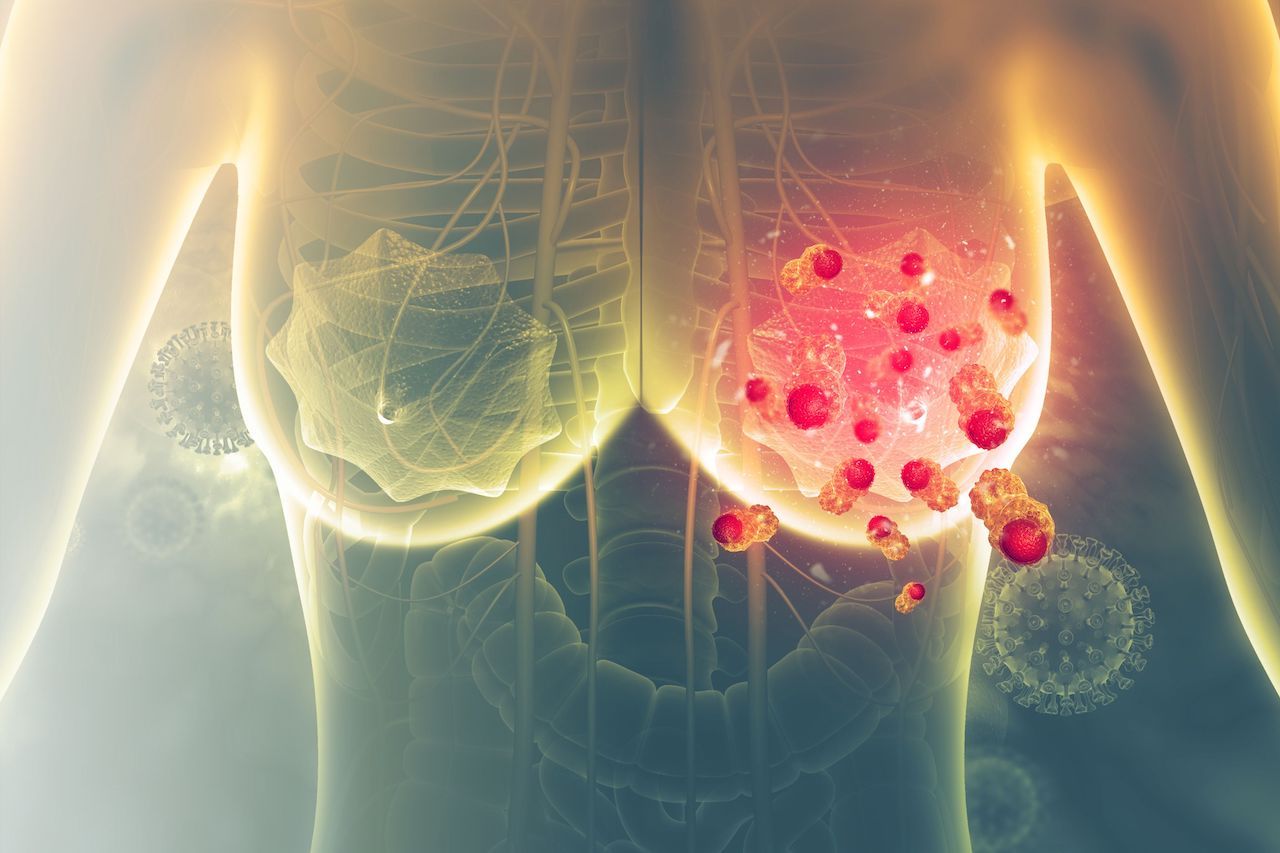- Center on Health Equity & Access
- Clinical
- Health Care Cost
- Health Care Delivery
- Insurance
- Policy
- Technology
- Value-Based Care
Neoadjuvant KN026 Plus Docetaxel Demonstrate Early Activity in HER2+ Breast Cancer
A combination of KN026, a novel bispecific antibody, and docetaxel elicited responses with an acceptable toxicity profile when administered as neoadjuvant treatment in patients with HER2-positive (HER2+) early or locally advanced breast cancer.
OncLive® first published this article. This version has been lightly edited.
Breast cancer
Image Credit: Crystal Light - stock.adobe.com

The novel bispecific antibody KN026 and docetaxel elicited responses with an acceptable toxicity profile when administered as neoadjuvant treatment in patients with HER2-positive (HER2+) early or locally advanced breast cancer, according to data from a single-arm, multicenter, phase 2 study (NCT04881929) presented at the 2023 European Society for Medical Oncology Congress.
The regimen elicited a pathological complete response (pCR) rate of 56.7% (95% CI, 37.43%-74.54%) in this population; the posterior probability for a total pCR greater than 40% was 96.7%. The breast pCR rate was 60.0% (95% CI, 60.0%-77.34%). Moreover, the overall response rate (ORR) was 90% (95% CI, 73.47%-97.89%), and the confirmed ORR was 86.7% (95% CI, 69.28%-96.24%).
“KN026 combined with docetaxel as neoadjuvant treatment has shown promising clinical benefit for patients with HER2-positive early or locally advanced breast cancer with an acceptable and manageable safety profile,” Lin Xiaoxi Ma, MD, stated, in a poster presentation of the data. “Further validation in a large-scale randomized controlled trial is warranted.”
Although targeted therapies have advanced the neoadjuvant treatment of patients with early, locally advanced, HER2+ breast cancer, efficacy with these approaches remains limited. As such, efforts are needed to fill the need for this population.
KN026 targets the distinct extracellular domains II and IV of HER2. Prior data suggest that the investigative agent has stronger antitumor activity than single-agent trastuzumab (Herceptin; Roche) or pertuzumab (Perjeta; Roche). A series of trials done in late-line HER2+ solid tumors and frontline HER2+ breast and gastric cancers has shown efficacy of the agent.
The phase 2 trial enrolled patients 18 years and older with early-stage or locally advanced HER2+ disease. Patients needed to have early disease, defined as T1c or 2, N1, M0, T2 or 3, N0, or M0, or locally advanced disease, defined as T1c or 2 or 3, N2, M0, T3N1M0, T1c or 2 or 3, N3a or 3b, or M0. They also needed to have a left ventricular ejection fraction of 55% or higher.
Study participants received KN026 at 30 mg/kg plus docetaxel at 75 mg/m2 every 3 weeks for 4 cycles. Patients went on to receive surgery and underwent pathological evaluations.
Total pCR, which was defined as absence of any residual invasive cancer in the breast and lymph nodes, was the primary end point. Secondary end points included pCR in the breast, ORR, safety, pharmacokinetics, and immunogenicity.
Between August 9, 2021, and July 29, 2022, 30 patients were enrolled onto the study. Twenty percent of patients were 40 years or younger, 73.3% were aged 41 to 64 years, and 6.7% were at least age 65 years. Most patients had an Eastern Cooperative Oncology Group performance status of 0 (96.7%). Regarding T stage, 80.0% had T2 disease and the remaining 20.0% had T3 disease. More than half (53.3%) of patients had N1 disease, 33.3% had N2 disease, and 13.3% had N0 disease. All patients had M0 disease. Regarding clinical stage, 46.7% had stage IIIA disease, 43.3% had IIB disease, and 10.0% had stage IIA disease. Half of patients had hormone receptor positivity.
Of the 30 patients enrolled onto the study, 28 completed surgery and received pathological evaluations. Two patients discontinued from the study due to adverse effects (AEs).
Additional subgroup data show that the total pCR rate was numerically higher in those with hormone receptor negativity (n = 15) vs those with hormone receptor positivity (n = 15): 73.3% (95% CI, 44.90%-92.21%) vs 40.0% (95% CI, 16.34%-67.71%). The total pCR was also numerically higher in those with stage II disease (n = 16) vs those with stage III disease (n = 14): 68.8% (95% CI, 41.34%-88.98%) vs 42.9% (95% CI, 17.66%-71.14%).
The total pCRs were numerically similar in other subgroups. In the groups of patients 40 years and younger (n = 6), 41 to 64 years (n = 22), and 65 years and older (n = 2), the total pCRs were 50.0% (11.81%-88.19%), 54.5% (32.21%-75.61%), and 100% (15.81%-100%), respectively. In in those with a primary tumor size of 5 cm or smaller (n = 25) or larger than 5 cm (n = 5), these rates were 56.0% (34.93%-75.60%) and 60.0% (14.66%-94.73%), respectively. The total pCRs were 50.0% (6.76%-93.24%) and 57.7% (36.92%-76.65%) in patients with positive (n = 26) or negative (n = 4) lymph node status, respectively.
Regarding safety, treatment-emergent AEs (TEAEs) occurred in all patients, with 53.3% experiencing grade 3 or higher effects. TEAEs led to interruption and withdrawal for 13.3% and 6.7% of patients, respectively, and 6.7% had TEAEs that led to withdrawal of docetaxel. Two serious AEs occurred, with 1 each related to KN026 and docetaxel. Moreover, 53.3% of patients experienced at least 1 TEAE.
AEs included decreased neutrophil count (50.0%), decreased white blood cell count (40.0%), decreased lymphocyte count (10.0%), increased gamma-glutamyltransferase (3.3%), increased alanine aminotransferase (3.3%), febrile neutropenia (3.3%), hepatitis E (3.3%), dermatitis acneiform (3.3%), diarrhea (3.3%), and hypersensitivity (3.3%).
Reference
Ma L, Yang B, Zhang M, et al. 247P KN026 in combination with docetaxel as neoadjuvant treatment for HER2+ early or locally advanced breast cancer (BC): A single-arm, multicenter, phase II study. Ann Oncol. 2023;34(suppl 2):S282. doi.org/10.1016/j.annonc.2023.09.445
